
Artocarpus is a genus of approximately 60 trees and shrubs of Southeast Asian and Pacific origin, belonging to the mulberry family, Moraceae. Most species of Artocarpus are restricted to Southeast Asia; a few cultivated species are more widely distributed, especially A. altilis (breadfruit) and A. heterophyllus (jackfruit), which are cultivated throughout the tropics.
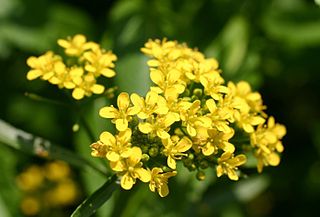
Rorippa is a flowering plant genus in the family Brassicaceae, native to Europe through central Asia, Africa, and North America. Rorippa species are annual to perennial herbs, usually with yellow flowers and a peppery flavour. They are known commonly as yellowcresses.
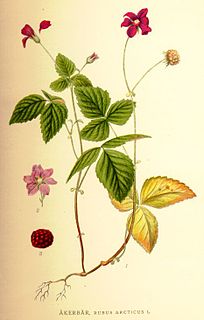
Rubus arcticus, the Arctic bramble or Arctic raspberry, is a species of slow-growing bramble belonging to the rose family, found in arctic and alpine regions in the Northern Hemisphere.

Cornus canadensis is a species of flowering plant in the dogwood family Cornaceae, native to eastern Asia and North America. Common names include Canadian dwarf cornel, Canadian bunchberry, quatre-temps, crackerberry, and creeping dogwood. Unlike its relatives, which are for the most part substantial trees and shrubs, C. canadensis is a creeping, rhizomatous perennial growing to about 20 centimetres tall.

Arctous alpina, the alpine bearberry, mountain bearberry or black bearberry, is a dwarf shrub in the heather family Ericaceae. The basionym of this species is Arbutus alpinaL..

Abies lasiocarpa, the subalpine fir or Rocky Mountain fir, is a western North American fir tree.
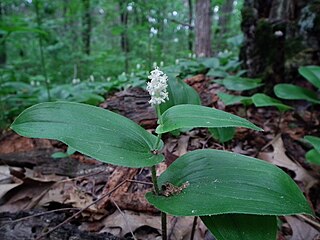
Maianthemum canadense is an understory perennial flowering plant, native to Canada and the north-eastern United States, from Yukon and British Columbia east to Newfoundland, into St. Pierre and Miquelon. It can be found growing in both coniferous and deciduous forests. The plant appears in two forms, either as a single leaf rising from the ground with no fruiting structures or as a flowering/fruiting stem with 2-3 leaves. Flowering shoots have clusters of 12–25 starry-shaped, white flowers held above the leaves.

Maianthemum racemosum, the treacleberry, feathery false lily of the valley, false Solomon's seal, Solomon's plume or false spikenard, is a species of flowering plant native to North America. It is a common, widespread plant with numerous common names and synonyms, known from every US state except Hawaii, and from every Canadian province and territory, as well as from Mexico.

Actaea rubra, the red baneberry or chinaberry, is a poisonous herbaceous flowering plant in the family Ranunculaceae, native to North America.
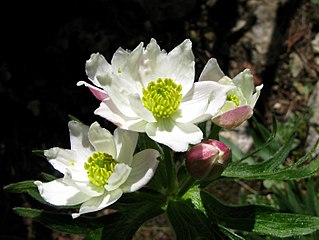
Anemonastrum narcissiflorum, the narcissus anemone or narcissus-flowered anemone, is a herbaceous perennial in the genus Anemonastrum and the buttercup family. Basionym: Anemone narcissiflora Hook. & Arn.

Malus baccata is an Asian species of apple known by the common names Siberian crab apple, Siberian crab, Manchurian crab apple and Chinese crab apple. It is native to much of northern Asia, but is also grown elsewhere as an ornamental tree and for rootstock. It is used for bonsai. It bears plentiful fragrant white flowers and edible red to yellow fruit of about 1 cm diameter.

Rorippa palustris, marsh yellow cress, is a species of flowering plant in the family Brassicaceae. It is widespread and native to parts of Africa, and much of Asia, Europe and Eurasia, North America and the Caribbean. It can also be found in other parts of the world as an introduced species and a common weed, for example, in Australia and South America. It is an adaptable plant which grows in many types of damp, wet, and aquatic habitat. It may be an annual, biennial, or perennial plant, and is variable in appearance as well.
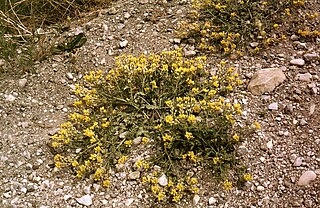
Rorippa columbiae is a species of flowering plant in the family Brassicaceae known by the common names Columbian yellowcress and Columbia yellow cress.

Rorippa curvipes is a species of flowering plant in the family Brassicaceae known by the common name bluntleaf yellowcress. It is native to much of western North America from Alaska to Mexico to the Mississippi River, where it can be found in various types of moist and wet habitat, including lakeshores and riverbanks, meadows, roadsides, mudflats, and irrigation ditches. It is an annual or perennial herb, producing several stems growing prostrate along the ground or somewhat upright, measuring 10 centimeters to around half a meter in maximum length. The leaves are long and narrow, smooth edged or lobed, the lobes sometimes cut all the way to the midrib or separated to form leaflets. Lower leaves are borne on petioles; upper leaves have bases that clasp the stem. The mustardlike flowers have very small yellow petals. The fruit is a plump, hairless silique containing many minute seeds.

Rorippa curvisiliqua is a species of flowering plant in the family Brassicaceae known by the common name curvepod yellowcress.

Arnica chamissonis, the Chamisso arnica, is a North American species of plants in the family Asteraceae. It is very similar to Arnica montana. Arnica chamissonis is native to North America and naturalized in parts of Europe while A. montana is indigenous to Europe.

Aquilegia brevistyla is a species of flowering plant in the buttercup family known by the common name smallflower columbine. It is native to northern North America, where it has a disjunct distribution. Most of its range extends from Alaska through much of Canada, and it also occurs in a few areas in the contiguous United States, such as the Black Hills of South Dakota and central Montana. It is most common in eastern Alaska, Yukon, the southern Northwest Territories, and northern parts of Alberta, Manitoba, and Saskatchewan.
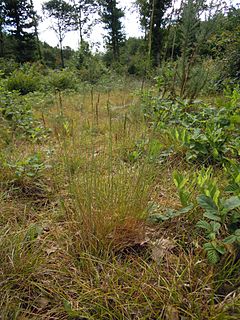
Agrostis vinealis is a species of grass known by the common names brown bentgrass and brown bent, which can be found from Russia to Mongolia, China, Pakistan, India and Alaska. It was introduced to Greenland and South Georgia and the South Sandwich Islands.

Askellia pygmaea, the dwarf alpine hawksbeard, is a species of Asian and North American plants in the tribe Cichorieae within the family Asteraceae.
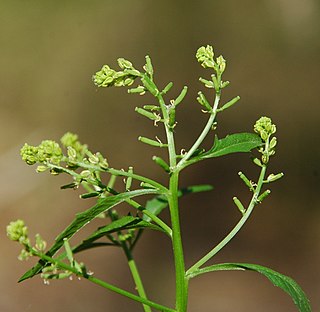
Rorippa sessiliflora, commonly known as stalkless yellowcress, is a species of flowering plant in the family Brassicaceae.



















